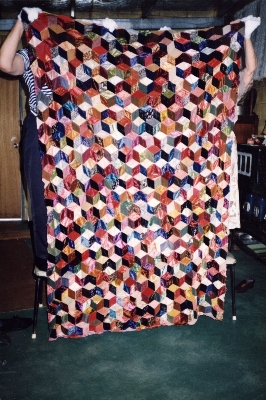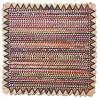Quilt No.333GM - Gundagai Historical Museum

2070 x 1500mm
Made in the 1940s by Mary McLean (1877 - 1971) of 'Big Ben', Gundagai (NSW). Previously owned by Mary McLean. Now owned by the Gundagai Museum.
" Miss Mary McLean of 'Big Ben' died on Friday morning, severing a link with Gundagai's pioneering past.
She was 94 years of age.
The late Miss McLean was the last survivor of one of Gundagai's great pioneering families. She lived all her life in this district, and at the time of her death was still residing at 'Big Ben' at Willie Ploma.
Truly a grand old lady, Miss McLean loved to tell the tales of the early days in this district.
Declining health in the last years kept her out of the public eye, but for many years she had given the people of this district a sterling example of citizenship. The late Miss McLean was a daughter of one of the old teamsters, Johnnie McLean, who used to drive bullock teams from Sydney to Gundagai before the railway had reached out.
In the year 1884 he and another teamster Jack Story, loaded at Pyrmont the cylinders which are in Prince Alfred Bridge, Gundagai.
When John McLean first [?] on Big Ben Creek, he gave it the name from a shepherd known as Big Ben, who was shepherding sheep in the area.
Mary McLean was born at her parents' home, 'Stonefield', on Big Ben Creek on February 2, 1877. She lived on Big Ben Creek all her life.
Her father, John McLean, was one of the pioneer farmers of this district, cultivating some areas, but concentrating mainly on cattle raising.
Upon his death in 1927, Miss McLean and her sister Isabella commenced dairying.
Her main interests included the Red Cross Society for whom she was a tireless worker. Her handwork, knitting and crocheting, was much in demand. A staunch member of the Presbyterian Church, Miss McLean was organist at St David's Church, Gundagai, for many years.
Particular interests she held were in the Burnside presbyterian Homes at Carlingford and the Australian-Inland Mission.
A keen gardener, Miss McLean built the present home on Big Ben in 1931 and planned and built the gardens herself. She was an avid reader and had an active interest in all activities associated with rural development.
Always interested in world events, Miss McLean had one of the first radios seen in this district, a wet battery set.
Her great interest was in her family, and Big Ben was the holiday home for all her nieces and nephews. During school holidays Big Ben was inundatd with children.
A brother and sister survive Miss McLean. They are John (Mirool) and Isabella (Sydney).
Miss McLean had twenty-one nieces and nephews, 39 grand nieces and nephews and 34 great grand nieces and nephews. �"
[Obituary from the Gundagai Times, 1971.]
Related Quilts:
The backing is maroon cotton. 1600 x 1600 mm.
The quilt is of three layers because the strips of the log cabin are attached to a backing piece, and then the quilt is lined; however it is not padded." [NGA]
1400 x 930mm
1570 x 152Omm
Quilt is hand pieced.
1000 x 1000mm






